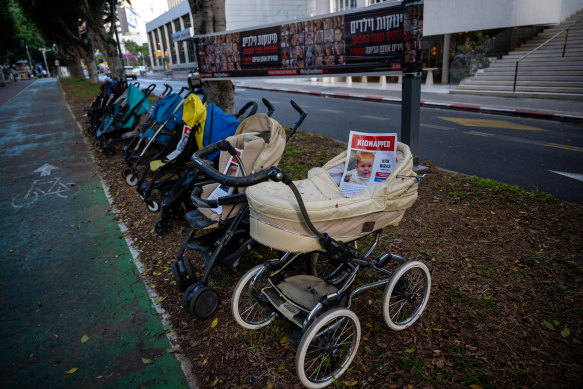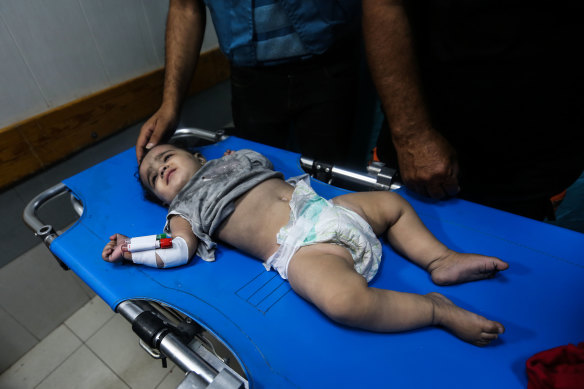Save articles for later
Add articles to your saved list and come back to them any time.
Nearly two dozen Israeli children lost both their mother and father in the October 7 Hamas terror attack that sparked the escalating war, while scores more children lost one parent.
In an interview with this masthead, senior Israeli official Liora Abramovich confirmed the parents of 17 boys and girls were murdered in the incursion that has provoked fierce scrutiny of the Netanyahu government’s border security measures.
An installation of strollers with the faces of children kidnapped by Hamas, in Tel Aviv, on Saturday.Credit: Getty
Another four children had one parent murdered and another go missing or taken hostage, while a further 100 Israeli children aged between 10 months and 16 years had one parent murdered and the other survive.
Sisters aged three and seven watched from the back seat of a car as their parents were killed in the front seats attempting to flee the scene of a siege, Abramovich said. The girls were taken to a synagogue and taken care of by people unknown to them before their aunt and uncle were contacted and were able to collect them.
In another case, a six-year-old boy watched his parents be shot and killed and was himself wounded by a bullet but survived.
Destroyed furniture and charred walls are seen in a Kibbutz Nir Oz home that came under attack during the Hamas invasion on October 7.Credit: AP
Abramovich, a top legal official at Israel’s Social Affairs Ministry responsible for the care of the orphaned children, said her agency’s top priority was to fast-track foster arrangements and ensure the children were in the safe hands of relatives.
“We’re embracing the children,” she said. “We know the social services are working day and night to help all the families.”
“According to what we’ve heard from the social workers who have met with the children and their relatives, there is a wide range of reactions and expressions to the horrors”.
“Some of the children are not speaking at all. Others don’t stop talking and describing every detail to anyone who asks and talks to them.”
“There are regressive behaviours such as bed-wetting, fear of sleeping alone, fear of loud noises. It is too early to tell how the effects of the events of that day and the continuing stress they are experiencing will present themselves in the future.”
Since Hamas’ unprecedented attack, which Israel said killed more than 1400 people – 1100 civilians and 300 soldiers – Israel has pounded the Gaza Strip and killed more than 10,000 people, including 4100 children and 2640 women, according to figures from the Hamas-run Health Ministry.
A Palestinian child receives treatment at Nasser Medical Hospital in Khan Yunis, southern Gaza, after Israeli air raids.Credit: Getty
Israel’s right-wing Prime Minister Benjamin Netanyahu has not acknowledged any personal failure in his government’s inability to foresee or react swiftly to the Hamas attack. But analysts have predicted a political reckoning for the long-time leader after the war.
Netanyahu caused public uproar and a rift within his war cabinet when he posted on X, formerly Twitter, saying “at no time and no stage was a warning given regarding war intentions of Hamas.”
“On the contrary, all security officials, including the head of army intelligence and the head of the Shin Bet [Israel’s internal security service], estimated that Hamas was deterred and interested in an arrangement,” he wrote.
The post was deleted and in a second post, about 10 hours later, Netanyahu said: “I was wrong,” adding that his earlier comments “should not have been made and I apologise for that.”
Abramovich said that, on a personal note, her country was experiencing one of its toughest moments.
“We’re going through a really, really terrible [time]. Even those of us who are at work, we’re also dealing with it. I have two sons and two sons-in-law drafted.”
“It’s not easy.”
More coverage of the Hamas-Israel conflict
- Cascading violence: Tremors from the Hamas attacks and Israel’s response have reached far beyond the border. But what would all-out war in the Middle East look like?
- The human cost: Hamas’ massacre in Israel has traumatised – and hardened – survivors. And in Gaza, neighbourhoods have become ghost cities.
- “Hamas metro”: Inside the labyrinthine network of underground tunnels, which the Palestinian militant group has commanded beneath war-ravaged Gaza for 16 years. The covert corridors have long provided essential channels for the movement of weapons and armed combatants.
- What is Hezbollah?: As fears of the conflict expanding beyond Israel and Hamas steadily rise, all eyes are on the militant group and political party that controls southern Lebanon and has been designated internationally as a terrorist group. How did it form and what does Iran have to do with it?
Get a note directly from our foreign correspondents on what’s making headlines around the world. Sign up for our weekly What in the World newsletter.
Most Viewed in Politics
From our partners
Source: Read Full Article


